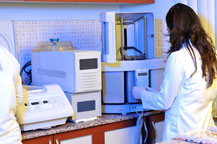 Indoor Air Quality is a significant concern because of recent research and testing that shows we are breathing more chemicals, VOCs, and chemical fumes than ever before. With the exception of a few lists of chemicals that are known to be absolutely horrible, there is little to no regulation of the chemical industry.
Indoor Air Quality is a significant concern because of recent research and testing that shows we are breathing more chemicals, VOCs, and chemical fumes than ever before. With the exception of a few lists of chemicals that are known to be absolutely horrible, there is little to no regulation of the chemical industry.
Chemicals are more of a concern than you might think. While cleaning chemicals you use in your daily activities are often dangerous, chemicals used to create, protect, or extend the life of products you buy aren’t always known. Imagine you buy a new shirt that says it is made from 100% cotton — what is not mentioned are the dyes used to create the colors or preservatives to keep away mold, moths, and other problems during shipping and storage. Running the shirt through the laundry doesn’t always remove these chemicals. You may notice that the shirt smells “new†when you buy it — that’s because it has chemicals on it, so wearing the shirt affects what you are breathing.
If that’s not scary enough…
Other indoor air quality concerns include combustion sources such as oil, gas, kerosene, coal, wood, and tobacco products; building materials and furnishings as diverse as deteriorated, asbestos-containing insulation, wet or damp carpet, and cabinetry or furniture made of certain pressed wood products; products for household cleaning and maintenance, personal care, or hobbies; central heating and cooling systems and humidification devices; and outdoor sources such as radon, pesticides, and outdoor air pollution.
Some sources, such as building materials, furnishings, and household products like air fresheners, release pollutants more or less continuously. Other sources, related to activities carried out in the home, release pollutants intermittently. These include smoking, the use of unvented or malfunctioning stoves, furnaces, or space heaters, the use of solvents in cleaning and hobby activities, the use of paint strippers in redecorating activities, and the use of cleaning products and pesticides in house-keeping. High pollutant concentrations can remain in the air for long periods after some of these activities.



